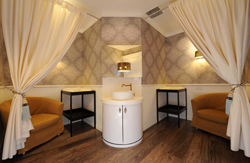I’ve been trying to think of how to approach this subject as recent events in the last few years have made women’s treatment in the Church a hot-button issue sure to elicit immediate knee-jerk responses of all kinds. Add to that my deeply ingrained cultural upbringing that comes from being a Minnesotan Mormon woman, and I’m loath to offend anyone, even those I disagree with. Also, making jokes is way funner than all this serious crap, so I’d rather be doing that. But sometimes you have to just say what’s going on and let the chips fall where they may, even if that means offending internet strangers (who I visualize typing in top-hats and monocles while sneering their disdain), or writing something serious when you’d rather dull the pain or intensity by making it funny. And at the end of this, I’m totally inviting you all over for some hot-dish, bars, and passive-aggressive disagreements because that’s how we roll in Minnesota.
In my very first post on Rational Faiths, I talked about how the lack of female narratives I grew up with in the Church had affected me and in some ways left me totally unprepared for things like pregnancy and childbirth. In the years since then, I also became aware of another institutional failing we seem to have in regards to women in the church: sacred spaces. As our church is currently set-up, there are only a few places found in the temple where no man can go, no matter how high his calling. However, outside the temple, there are several places no woman ever has the authority to enter, but not a single space where the reverse is true. There are always at least a handful of men who have the authority to enter women’s spaces and even dictate how that space should be run if they view that as necessary. And while most priesthood-holding leaders are thankfully not inclined to do that, our structure absolutely allows for it. Men are even allowed to be Relief Society President if the need should arise (and yes, I know someone who did this on his mission.) While this too is rare and only happens in exceptional circumstances, structurally it reinforces that it’s OK for men to run women’s spaces, but never the reverse.
Here’s the thing: I am fine with certain sacred spaces and rituals being gender-specific as long as they are treated with equal respect. In fact, as I am now pregnant again, I actually long for some kind of sacred ritual or space where I am surrounded by loving, holy women as I prepare to give birth,and I don’t want a man in sight. We don’t actually have women-only spaces in the church except for the brief spaces I mentioned in the temple. But these are ritual spaces. They are sacred, but they are not designed to be a place where women really interact with one another or minister to the individual’s or group’s needs. However, there are quite a few examples of rituals and spaces outside the temple where the men-only status is adamantly defended.
Recently I’ve read several anecdotal stories about local leadership cracking-down on the idea of a woman holding her baby while it is being blessed, with the justification that this is supposed to be a priesthood-only function. A Facebook acquaintance (who will remain anonymous out of respect for all involved) shared that while his wife was allowed to hold their first child several years ago while the child was being blessed, they were refused this time around, even though their current child has sensory issues and it was mainly a health concern that prompted their asking permission. Unfortunately their local leaders had found out about some comments made on Facebook in support of women being able to hold their children during a baby blessing in general. Even though their stake president acknowledged they had a valid reason for the mother to hold the baby, these comments in support of a woman participating in the blessing essentially disqualified them in the eyes of their leaders.
Now while the crack-down on baby blessings might be seen as a recent response to movements like Ordain Women, it is far from the only example of the Church adamantly defending it’s male-only spaces. Even before Ordain Women came along, the general Priesthood session of general conference was closely guarded against accidental ovaries stepping inside the meeting. In this article, the history of the last female reporter being allowed inside the building is recounted. This was in 1993, and the reporter was a woman from Ricks College who had been cleared to attend by the Church Public Affairs Department. I will share an excerpt from the article about the discomfort having a woman in a “man’s-only” sacred space seemed to create:
“President Bennion [President of Ricks at the time] said he got a call from one of the brethren that morning who saw a woman at the Priesthood session. He wanted to know who she was and tracked me down through Church Public Affairs. President Bennion relayed that the caller wondered about my purpose and felt that having me there was a distraction…As much as I enjoyed the content of the Priesthood Session and the palpable strength in the sea of suits, I had garnered far more attention than the brothers by my side — and perhaps more than some of the speakers. I couldn’t deny that my attendance had been somewhat uncomfortable for me and clearly confusing to some men in the Tabernacle.”
The following conference, only male reporters were allowed to attend. This is not the only example of women being forbidden from attending just to do their jobs. All ushers, camera operators and even choir conductors must be male. At the March 31 Priesthood session in 2007, the BYU Men’s chorus was part of the featured music. Their conductor, Dr. Rosalind Hall prepared them for the meeting but was not allowed to actually conduct during the priesthood session, so she was replaced for just that performance by Ronald Staheli. I don’t think I need to review the recent history of Ordain Women seeking entrance. Read any LDS blog from last year if you need a refresher. What is ironic in all of this, is how many men are present not just as speakers, but as ushers, camera operators, etc. at the General Women’s Meeting, and I have yet to hear of the women being made uncomfortable by it. Probably because we’re used to men coming into our spaces more than the reverse.
Now as I said earlier, I am not opposed to some sacred spaces being divided according to gender. In this life being a man or woman is a very different experience for many reasons, and it can be powerful to feel united with others who share that experience. What I don’t understand is why there isn’t an equally guarded space for women in our church. Outside of the temple there are no rituals, no meetings, and no spaces where we feel it so important to create a women’s-only space, that men-even priesthood leaders- must gain permission from women to attend or be involved. Now in my personal experience, most of my male leaders have been respectful of women’s gatherings, and I sincerely appreciate that. However, when the bishop wants to make an announcement in Relief Society, if he asks permission it’s more out of politeness than any real need to get approval. Technically he has more authority in that room than any woman, including the Relief Society President. The space may be inhabited by women, but it is still presided-over by him, and therefore not truly a woman’s space in the same way a priesthood ordinance, high council room or General Priesthood Meeting are absolutely and totally spaces for men only, and enforced to stay that way.
Is it any wonder that the brethren have had to emphasize the importance of including women in ward councils and in getting them to speak up? We have an organizational precedent of spaces at church belonging to priesthood-holding men who decide when and where women are allowed to participate or not participate. This is going to bleed into our culture. For an oft-commented upon example, one can look at the inconsistency of how mother’s lounges are handled across the church.
I supposed this is the one area outside the temple (and apart from the bathroom) where men won’t go in unless the women say it’s OK first. However, where the space is, how well it serves the women who use it, and if it even exists at all, is still decided-on by priesthood-holding men. I have been to wards with great mother’s lounges that are complete with changing tables, disinfectant wipes, a diaper genie to prevent stench, and even a pack n play. On the other hand, the mother’s lounge in my current building, a stake center with 3 wards meeting in it, is the size of a walk-in closet stuffed with 3 rocking chairs and an open garbage can. My guess is that there may have never really been a mother’s lounge built and this room was thrown together, or it got re-appropriated for something else. I doubt there was any intentional oversight, but I have never seen a stake center fail to put in a sufficiently sizable high council room or clerk’s office. The importance of a mother’s lounge, the closest thing we have to a woman-only space, is at the discretion of local leaders, while the importance of certain male-only or male-controlled spaces (like those previously mentioned) is usually set in Church-policy stone.
So what is a possible solution to all this? What would I wish for in a “perfect world?”
Well, for one thing I would be happy just revisiting some of the rituals and spaces we used to have for women in the Church. Midwives were once called and set apart not just to help medically, but to bless and anoint the women they were serving. It was as much a spiritual calling as a physical one. Even just allowing women to give blessings of healing when it might be easier for a woman to be ministered to by another women would be lovely. (I am thinking of not only cases of child-birth, but women’s health issues or recovering from abuse.) Healing blessings do not fall solely under the Priesthood. From Linda King Newell’s article in Sunstone called “A Gift Given: A Gift Taken,” we find this quote from Joseph Smith:
“someone apparently reported to Joseph that the women were laying their hands on the sick and blessing them. His reply to the question of the propriety of such acts was simple. He told the women in the next meeting “there could be no evil in it, if God gave his sanction by healing.., there could be no more sin in any female laying hands on the sick than in wetting the face with water.” He also indicated that there were sisters who were ordained to heal the sick and it was their privilege to do so. “If the sisters should have faith to heal,” he said, “let all hold their tongues.”
Now if you are looking for a more orthodox source than Sunstone, there is also an excellent article on women’s blessings in the early Church at the Women in the Scriptures blog. She also gives a brief overview of when and why it fell out of practice, and mentions ways to look for healing and ministering among women today.
Additionally, my perfect world would include a return to more Relief Society autonomy so women could define their own spaces for themselves and work with the priesthood-holding men side-by-side, instead of under them as an auxiliary of the Priesthood. (For a great history on Relief Society autonomy and how it eroded, this podcast at Feminist Mormon Housewives is fascinating.) I am personally OK with not holding the priesthood as long as women are given an equivalent power and authority within the Church to create and inhabit our own spaces, do our own works, and work together with Priesthood-holders on equal terms of respect and spiritual authority. The women of the Relief Society did so much on their own that was eventually swallowed up in correlation and handed over to Priesthood leaders. The original Church magazine that is now the Ensign, church manuals, and massive grain storage were all done independently. While I understand the need to have an organized structure, and correlation has done a lot of good in many areas, there are still things we have sacrificed for it, and most of those sacrifices were from women in terms of space, power and autonomy.
While I do long for the Church to acknowledge and protect the importance of sacred, independent spaces and rituals for women the same way they do for men, I am still finding other ways to cultivate those things. Usually I have to borrow an idea or two from another culture, but sometimes combining those ideas with the network of wonderful women I know at Church can be great. For example, one of the women in my ward has been kind enough to throw me a baby shower and we have talked about incorporating some of the ideas of a blessingway/Mother’s Blessing into it as opposed to just gifts and games. What I really need more than baby clothes is spiritual and emotional support from the great women I know, so I hope we find some way to create that kind of space without freaking-out the more traditional crowd.
In conclusion, I feel like I am left in the same place I mention at the end of my first blog post. I am reminded once again that as an institution, the Church provides many great things, (truly, my ward is amazing and helps me see God in action), but I cannot rely on it to provide for every emotional and spiritual need I may have. Some of my current needs will have to be met elsewhere, or at least in rather unorthodox ways. While I wish they could all be met in a one-stop Church shop, the Church only goes as far as its members’ understanding as we try to create a better structure to live the Gospel in, and that’s OK. God can take care of the rest, but I’ll still hope and pray and work towards a more robust structure that honors the sacred feminine and helps us all to have a deeper experience and understanding of God and each other.









Amen. A lovely, kind, thought-provoking article that invites open, respectful dialogue.
Very nicely put!
I would be so interested in what you do for your blessingway! I hope you’ll share.
Right now we’re talking about making a text-list for those who want to be on it so when I go into labor they will get a text and can say a prayer for me. We might hand out candles too as part of that, but really I just want to feel the support of my friends and borrow some of their courage and love. We also will probably have a designated time where we share our own stories (or those of our family) about birth. We’ll see how it goes!
As an aside, at one time a non-member father could hold his baby while it was being blessed. My father held several of us. So, it wasn’t just a change against women. My youngest brother, who turns 50 this year, was not held by my father so that change was between 50 and 60 years ago.
Wise words written from personal experience! God bless the faithful women and young mothers in our congregations!
Outstanding post, Laurel! It really is sad that we’re so intent on having men preside everywhere that we really can’t let women have any women-only sacred spaces. I think your example of the mother’s lounge is spot on too. Sometimes it’s very literally out of (men’s) sight, and so out of (men’s) mind, so nothing is done to make it comfortable. It really highlights how much women’s experience in the Church is dictated by the goodwill of the men in power around them, since we refuse to give them any real power.
I love love Love this post. It speaks my heart!